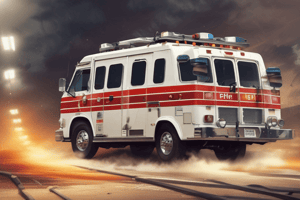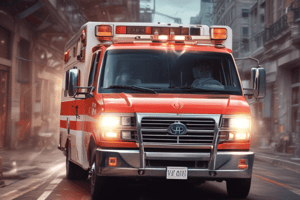Podcast
Questions and Answers
What should you do for a 20-year-old male with a large laceration to his wrist who is holding a blood-soaked towel?
What should you do for a 20-year-old male with a large laceration to his wrist who is holding a blood-soaked towel?
- Apply direct pressure to the wound
- Call for emergency assistance
- Leave the towel in place
- Apply a tourniquet proximal to the wrist (correct)
After applying supplemental oxygen to a 59-year-old male presenting with severe vomiting and diarrhea, what should you do next?
After applying supplemental oxygen to a 59-year-old male presenting with severe vomiting and diarrhea, what should you do next?
- Give anti-nausea medication
- Administer IV fluids
- Prepare for immediate transport (correct)
- Monitor his vitals
What causes septic shock?
What causes septic shock?
Poor vessel function and severe volume loss
What is the most appropriate treatment for a construction worker who fell and has a blood pressure of 70/50 mmHg?
What is the most appropriate treatment for a construction worker who fell and has a blood pressure of 70/50 mmHg?
What should you do for a patient with a severe leg injury and active bleeding?
What should you do for a patient with a severe leg injury and active bleeding?
Blood pressure may be the last measurable factor to change in shock.
Blood pressure may be the last measurable factor to change in shock.
What condition should you be most suspicious of in a 70-year-old female with a blood pressure of 90/64 mmHg and hot, moist skin?
What condition should you be most suspicious of in a 70-year-old female with a blood pressure of 90/64 mmHg and hot, moist skin?
Which condition should not make you suspect shock?
Which condition should not make you suspect shock?
What are capillary sphincters?
What are capillary sphincters?
Which factor would not typically result in cardiogenic shock?
Which factor would not typically result in cardiogenic shock?
Which clinical sign is not consistent with compensated shock?
Which clinical sign is not consistent with compensated shock?
What causes distributive shock?
What causes distributive shock?
What is lost in hypovolemic shock caused by severe burns?
What is lost in hypovolemic shock caused by severe burns?
What is typically accompanied by neurogenic shock?
What is typically accompanied by neurogenic shock?
What causes neurogenic shock?
What causes neurogenic shock?
What is one of the primary waste products of normal cellular metabolism that must be removed by the lungs?
What is one of the primary waste products of normal cellular metabolism that must be removed by the lungs?
During which condition does pulmonary edema and impaired ventilation occur?
During which condition does pulmonary edema and impaired ventilation occur?
What is shock a result of?
What is shock a result of?
To protect vital organs during shock, blood flow is redirected away from which organ?
To protect vital organs during shock, blood flow is redirected away from which organ?
Which clinical sign is unique to anaphylactic shock?
Which clinical sign is unique to anaphylactic shock?
Which injury is most likely to cause obstructive shock?
Which injury is most likely to cause obstructive shock?
Which patient is most likely in decompensated shock?
Which patient is most likely in decompensated shock?
Which statement about anaphylactic shock is correct?
Which statement about anaphylactic shock is correct?
Which situation is most likely to result in hemorrhagic shock?
Which situation is most likely to result in hemorrhagic shock?
What is the only action that can prevent death from a tension pneumothorax?
What is the only action that can prevent death from a tension pneumothorax?
Flashcards are hidden until you start studying
Study Notes
Shock Overview
- Shock results from hypoperfusion to the body’s cells, leading to cell dysfunction.
- Blood pressure may be the last measurable factor to change in shock scenarios.
- Compensatory mechanisms redirect blood flow from organs tolerant of low flow, such as the skin.
Types of Shock
- Hypovolemic Shock: Caused by severe volume loss, such as plasma loss from burns or hemorrhage.
- Cardiogenic Shock: Resulting from poor cardiac function, increased afterload, or heart attack. Symptoms include pulmonary edema and impaired ventilation.
- Neurogenic Shock: Caused by failure of the nervous system, leading to widespread vasodilation and often accompanied by hypothermia.
- Septic Shock: Often develops from severe infections, resulting in poor vessel function and significant volume loss.
- Distributive Shock: Characterized by widespread blood vessel dilation causing pooling of blood in vascular beds.
- Obstructive Shock: Caused by mechanical obstruction, such as cardiac tamponade.
Clinical Signs and Symptoms
- Compensated shock shows restlessness, rapid breathing, and cool, clammy skin. Absent peripheral pulses indicate decompensated shock.
- Anaphylactic shock presents with unique symptoms such as wheezing, dizziness, and hypotension.
Patient Management
- For severe bleeding, such as a partial amputation, apply direct pressure and monitor vital signs.
- In cases of septic shock, prepare for immediate transport if the patient shows confusion, diaphoresis, and low blood pressure.
- Assisted ventilation and thermal management are critical for unconscious patients with potential spinal injuries.
Complications and Responses
- Excessive sweating, diarrhea, or vomiting can lead to hypovolemic shock but liver laceration is most likely to cause hemorrhagic shock.
- Decompressing the chest is essential for resolving tension pneumothorax to prevent fatality.
- Subsequent exposures to allergens after sensitization worsen reactions, highlighting the importance of immediate treatment for anaphylactic shock.
Assessment and Recognition
- Be suspicious of septic shock in patients recently discharged after surgical procedures, exhibiting hot, moist skin and low blood pressure.
- Recognize that not all conditions leading to shock involve clear symptoms; ischemic stroke is one exception that does not typically present as shock.
Key Actions in Emergency
- Apply a tourniquet when severe limb bleeding is present.
- Maintain blood flow to vital organs during shock to ensure survival.
- Early intervention and transport can significantly affect outcomes in shock cases, particularly in anaphylaxis and septic presentations.
Studying That Suits You
Use AI to generate personalized quizzes and flashcards to suit your learning preferences.




